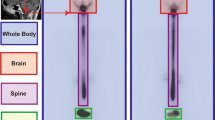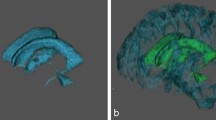Summary
In a retrospective study of 536 unselected consecutive RIHSA cisternographies a total of 84 cases with normal time-sequential scans were reviewed and, after dividing into three age groups, statistically elaborated with regard to the CSF pathways and flow rate. Our findings on a 5% level of significance are: 1) The total CSF flow and turnover depends on age; the highest rate of CSF flow is found in young patients (<25 years) and decreases constantly with increasing age. 2) In old patients (<50 years) the dorsal and lateral CSF pathways predominate over the frontomedial ones which are preferred in the younger age group (<25 years). 3) The washout of the basal cisterns and the clearance of the isotope over the convexities decreases significantly with increasing age. 4) The normal individual cisternographic variations and significant age-dependent differences agree with simultaneous encephalographic findings
Similar content being viewed by others
References
Alker, G. S., Leslie, E. V.: Isotope cisternography and ventriculography. Acta radiol. diagn. (Stockh.) 9, 589–596 (1969)
Bannister, R., Gilford, E., Kocen, R.: Isotope encephalography in the diagnosis of dementia due to communicating hydrocephalus. Lancet 2, 1014–1017 (1967)
Bligh, A. S., Schurtleff, D. B., Leach, K. G., Evans, N.: Isotope cisternography using 99mTc lavelled human albumin in spina bifida cystica. Cisternography and hydrocephalus (Ed. J. C. Harbert), Chap. 32, pp. 397–412. Springfield: Thomas 1972
Di Chiro, G.: Movement of the cerebrospinal fluid in human beings. Nature (Lond.) 204, 290–291 (1964)
Di Chiro, G., Reames, P. M., Matthervs, W. B.: RIHSA ventriculagraphy and RIHSA cisternography Neurology (Minneap.) 14, 185–191 (1964)
Di Chiro G.: Observations on the circulation of the cerebrospinal fluid. Acta radiol. diagn. (Stockh.) 5, 988–1002 (1966)
Front, D.: Scinticisternography and scintiventriculography. Groningen: V. R. B. Offsetdrukkery 1971.
Gordon, E., Greitz, T.: The effect of nitrous oxide on the cerebrospinal fluid pressure during encephalography. Brit. J. Anaesth. 42, 2–8 (1970)
Greitz, T., Grepe, A.: Encephalography in the diagnosis of convexity block hydrocephalus. Acta radiol. diagn. (Stockh.) 11, 232–242 (1971)
Greitz, T., Henriksson, L.E.: Age dependent variations of the subarachnoid space of the cerebral hemispheres in pneumoencephalography. To be published
Hammock, M. K., Milhorat, T. H., Davis, A. D.: Isotope cisternography and ventriculography in the diagnosis of hydrocephalus. Developm. Med. Child Neurol. 16, 58–71 (1974)
James, A. E., De Land, R. H., Hodgers, F. J., Wagner, H. N.: Cerebrospinal fluid (CSF) scanning: cisternography. Amer. J. Roentgenol. 110, 74–87 (1970)
Lying-Tunell, U., Söderborg, B.: Quantitative scintigraphic method of estimating the circulation of cerebrospinal fluid. Acta radiol. diagn. (Stockh.) 13, 554–569 (1972)
McCullough, D. C., Luessenhop, A. J.: Evaluation of photoscanning of the diffusion of intrathecal R. I. S. A. in infant and childhood hydrocephalus. J. Neurosurg. 30, 673–678 (1969)
McCullough, D. C., Harbert, J. C., Luessenhop, A. J.: Pediatric hydrocephalus: Contributions of radioisotope cisternography to diagnosis and management. Cisternography and hydrocephalus. (Ed. J. C. Harbert), Chap. 37, pp. 375–383. Springfield: Thomas 1972
Milhorat, T. H.: Hydrocephalus and the Cerebro-Spinal Fluid. Baltimore: Williams and Wilkins 1972
Mundinger, F., Anlauf, M., Bouchard, G.: Die cardiale Impulsfrequenzmessung des Jod131-Hippuran, eine neue Methode zur Passageprüfung ventrikulo-atrialer Shunts und die ventrikuläre Resorptionsprüfung zur Differentialdiagnose der Hydrocephali. Acta neurochir. (Wien) 11, 272–281 (1963)
Sanders, T. P., Sanders, T. D., Gallagher, E. J.: Quantitative studies of CSF dynamics. Cisternography and hydrocephalus. (Ed. J. C. Harbert), Chap. 37, pp. 463–470. Springfield: Thomas 1972
Voigt, K. Greitz, T.: Myeloscintigraphic patterns of injectionfailure, leakage and “lumbar resorption” in RIHSA-cisternography. To be published
Author information
Authors and Affiliations
Additional information
This work was done during Dr. Voigt's leave of absence from the Neurological Clinic of the University of Freiburg i. Br., FRG.
Rights and permissions
About this article
Cite this article
Henriksson, L., Voigt, K. Age-dependent differences of distribution and clearance patterns in normal RIHSA cisternograms. Neuroradiology 12, 103–107 (1976). https://doi.org/10.1007/BF00333125
Received:
Issue Date:
DOI: https://doi.org/10.1007/BF00333125




